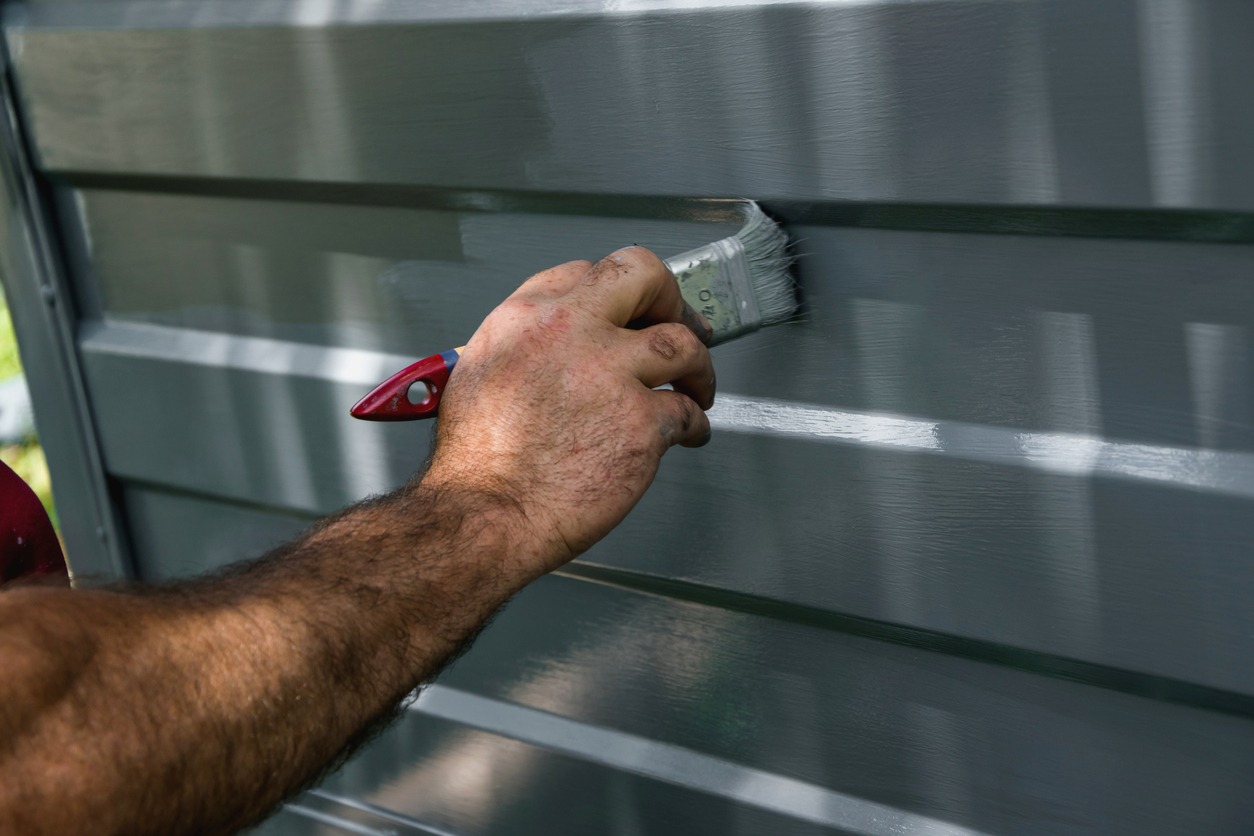Keeping metal doors in good condition is essential, particularly for businesses. If the metal doors of a commercial property are rusty, potential customers might think twice about availing of the business’s products or services.
Rust is the major enemy of metal. It compromises the structural integrity of doors and lessens the aesthetic appeal of your property. But with the right approach and expertise, a rusty metal door can be transformed through professional painting. Let us take a look at the process of reviving rusty metal doors. From initial cleaning to the final coat of paint, let us see how a skilled touch can breathe new life into your old doors.
Understanding Rust and Its Impact on Metal Doors
Rust is a common issue for metal doors, particularly those exposed to moisture and environmental elements. Understanding how rust forms and the effect of letting it go untreated is essential for maintaining the longevity and functionality of metal doors.
How and Why Rust Forms on Metal Doors
Rust occurs through a chemical process called oxidation. It is where iron (a common component of metal doors) reacts with oxygen in the presence of water or moisture. This reaction forms iron oxide, commonly known as rust. Factors that accelerate rusting include high humidity, salt (especially in coastal areas), and pollutants in the air. The presence of electrolytes in water can further speed up this process. This makes rainwater and salty air particularly detrimental.
Consequences of Rust Damage if Not Addressed Promptly
- Structural Integrity Compromise: As rust progresses, it eats away at the metal, causing it to weaken and become brittle. Over time, this can lead to holes and breaks in the door, undermining its ability to function as a secure barrier.
- Difficulty in Operation: Rust can cause parts of the door and its frame to expand and distort. This leads to issues like sticking or difficulty opening and closing the door smoothly.
- Increased Repair Costs: Addressing minor rust spots is relatively straightforward and inexpensive. However, if rust is allowed to spread, more extensive repairs or even full replacements may be required, leading to higher costs.
- Reduced Aesthetic Appeal: Rust spots and streaks can tarnish the appearance of a door, detracting from the overall look of a building. This can be problematic for commercial properties where first impressions matter.
- Decreased Property Value: Just as rust diminishes aesthetic appeal, it can also reduce the value of your property. Prospective buyers or tenants may see rust as a sign of poor maintenance. It can drive down property values and interest.
Pre-Painting Preparation for Rusty Metal Doors
Here are the key steps to stabilize the door’s condition and create a smooth base for paint application.
Cleaning the Door
- Dust and Debris Removal: Begin by wiping down the door with a damp cloth to remove dust, cobwebs, and loose debris. A detergent solution may be used for doors with significant grime buildup, followed by a rinse with clean water.
- Rust and Scale Removal: Scrub all rusted areas vigorously to remove as much rust as possible by using a wire brush or a handheld rotary tool with a wire wheel attachment. A power sander or an angle grinder outfitted with a sanding disc can be more effective for larger doors or more extensive rust.
- Chemical Rust Removers: Chemical rust converters can be applied in cases where mechanical removal is insufficient or impractical. These products dissolve the rust and create a primer layer over the iron, which prevents further oxidation.
Repairing Damage
- Filling Holes and Cracks: After removing the rust, inspect the door for any pits or holes that have formed. Use an auto-body filler or a specialized metal epoxy to fill these defects. Once the filler has cured, sand the area smoothly to align with the door’s surface.
Smoothing the Surface
- Sanding for Smoothness: Sand the entire door with medium-grit followed by fine-grit sandpaper. This smooths out the patched areas and scuffs up the existing paint, providing a better surface for the new paint to adhere to.
- Cleaning Post-Sanding: Dust off all sanding residue thoroughly with a clean cloth. Optionally, wipe down the door with a tack cloth or a cloth dampened with mineral spirits to ensure all dust is removed.
Priming
- Applying Primer: Choose a high-quality rust-inhibiting primer appropriate for metal surfaces. Apply the primer using a brush or a roller designed for metal surfaces. For best results, apply two coats of primer, allowing sufficient drying time as specified by the product instructions.
Masking Off Areas
- Protecting Hardware and Surroundings: Use painter’s tape to cover hardware, glass inserts, or any areas you do not want to be painted. You may also lay drop cloths or plastic sheeting around the work area to protect the flooring and nearby objects from paint drips and spills.
Following these preparatory steps will enhance the appearance of the painted door and prolong its lifespan by protecting it against future rust and decay.
Painting Techniques for Metal Doors
Here’s how you can apply paint effectively to give a rusty metal door a renewed appearance:
- Selecting Paint Type: Use a high-quality exterior paint designed for metal. These paints usually have rust-inhibiting properties and are formulated to withstand the elements. Acrylic latex paint is a popular choice for its ease of use and resistance to weathering.
- Color Selection: Consider the door’s exposure to sun and weather when choosing the color. Dark colors absorb more heat, which can lead to faster deterioration under intense sunlight, while lighter colors tend to last longer and remain vibrant.
- Tool Selection: Use a high-density foam roller or a paint sprayer for a smooth finish. Brushes can be used for smaller areas or for cutting in around hardware and window frames, but rollers and sprayers generally provide a more uniform coat.
- Primer Application: If not already applied during the preparation phase, apply a coat of rust-inhibiting primer. This helps the paint adhere better and provides an additional layer of protection against rust.
- Paint Application: Start by painting the edges and recessed or detailed areas with a brush. This is called “cutting in.” Next, use the roller or sprayer to cover the flat surfaces. Apply paint in a thin, even layer, moving in consistent patterns (either vertical or horizontal, but not both).
- Adding Second Coat: Assess the coverage after the first coat has dried completely. A second coat is often necessary to achieve an even finish and optimal color richness. Follow the same method as the first coat, ensuring the direction of the roller or sprayer matches the first application to avoid uneven textures.
- Maintaining a Wet Edge: To avoid lap marks, always maintain a wet edge by overlapping the previously painted area before the paint has dried. This technique helps blend each pass smoothly with the next.
- Sanding Between Coats: For an ultra-smooth finish, lightly sand the door with fine-grit sandpaper between coats. This removes imperfections and provides a better surface for subsequent coats to adhere to.
- Avoiding Drips and Sags: Be vigilant about the amount of paint loaded on your brush or roller. Too much paint leads to drips and sags, which can mar the finish. If using a sprayer, keep it moving at a consistent speed and distance from the door to apply even layers.
- Curing Time: Allow the paint to cure fully before reinstalling hardware or closing the door regularly. Curing times can vary based on paint type and environmental conditions, so refer to the manufacturer’s instructions for guidance.
By adhering to these painting techniques, you can ensure that your metal door looks refreshed and is well-protected against future wear and tear. These also help in maximizing its aesthetic appeal and longevity.
Benefits of Professional Service
Professionals bring expertise and efficiency that can greatly enhance the outcome and durability of the paint job. Here are some key benefits of hiring a professional painter:
- Quality of Workmanship: Professional painters possess the skills and experience required to achieve a high-quality finish. They understand the intricacies of surface preparation, paint application, and finishing techniques that might be challenging for amateurs.
- Knowledge of Materials: Professionals know the best products for any specific situation. These include the most effective rust-inhibiting primers and paints. Their knowledge extends to the latest advancements in painting technology and materials, ensuring your door benefits from the most effective solutions available.
- Time-Saving: Hiring professionals saves homeowners time. A professional crew can complete the job faster due to their skills and experience. This efficiency means less disruption to your daily routine.
- Equipment and Tools: Professional painters have access to high-grade equipment and tools, such as paint sprayers, professional-grade brushes, and safety gear. This ensures a more consistent and safe application than what might be achieved with DIY methods.
- Durability of the Paint Job: Thanks to their thorough preparation and precise application techniques, professionals can provide a paint job that lasts longer. This durability protects the metal door from the elements and delays the onset of future rust and degradation.
- Avoiding Mistakes: Mistakes in a DIY project can lead to additional costs and time spent fixing errors. Professionals are less likely to make mistakes and can guarantee their work, providing value for money in the long run.
- Warranty and Guarantee: Many professional painting services offer warranties for their work, giving you peace of mind. If the paint fails or the preparation shows flaws, they will typically remedy the situation at no extra cost.
- Professional Finish: A professionally painted door has a seamless, attractive finish that can boost the curb appeal of your property. This enhancement can be particularly important if you are considering selling your home.
- Customization: Professionals can offer customized solutions and finishes that might not be readily available to the average homeowner, such as textured paints or custom color matching.
- Increased Property Value: A well-maintained and aesthetically pleasing exterior can significantly increase the value of your property. The investment in professional painting services can thus pay dividends if you decide to sell your home.
Choosing a professional service to paint a rusty metal door ensures that the job is done right the first time. It also minimizes future maintenance and maximizes both the door’s functionality and aesthetic appeal.
Conclusion
Refreshing a rusty metal door with a professional paint job enhances its appearance, protects it, and extends its life. Tackling this project with professionals can ensure a top-quality finish and long-lasting results. If your metal door needs a facelift, don’t hesitate to contact Custom Painting, Inc. for reliable and professional service. Reach out at 925-294-8062 or use our contact form to get started on transforming your metal door today.



